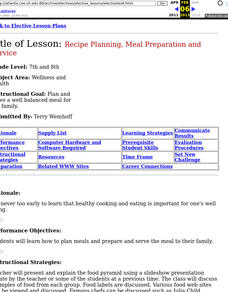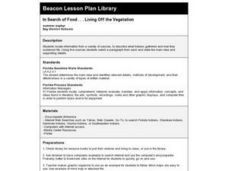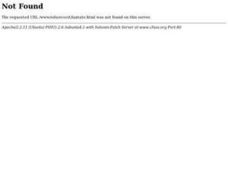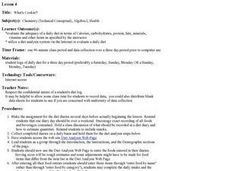Curated OER
The Barn Owl Pellet
Seventh graders examine the factors that affect the number and types of organisms that an ecosystem can support. In this ecosystem lesson students study the barn owl and where it is on the food chain, then dissect an owl pellet.
Curated OER
Recipe Planning, Meal Preparation and Service
Students examine how to plan, prepare, and serve a meal. They analyze the food pyramid, select five recipes, plan a dinner menu, create a HyperCard stack of the menu, and prepare the meal for their family.
Curated OER
How Many Birds Would It Take To Keep A Jackal Alive?
Students examine the role of large families in some animal populations. They work together to complete an activity related to food supply. They discover the relationship between preys and predators.
Curated OER
Edible Algae
Students acquire an awareness and appreciation for the value of the organisms in the Protist Kingdom. They identify common Protists, name them and list some common products that contain marine algae.
Curated OER
The Salmon Stream and Vegetation
Students explore the ecosystem and food chain by researching Pacific Salmon. In this fish habitat lesson, students discover the life cycle for salmon, where they spawn and what they eat to survive the harsh elements. Students participate...
Curated OER
The Unitary Method
In this math worksheet, students are given a proportion statement. They use this ratio to solve related questions. Students compute the amount of food needed for one person and then for 500 people. Students convert between Euros, Pounds,...
Curated OER
Introduction to Simulation Project
Students create a simulated self-sustaining ecosystem. In this biology lesson, students examine the different food chain and ecosystems in their model. They recommend some improvements and changes to an existing ecosystem.
Curated OER
Depending On Each Other. Communities And Ecosystems
Seventh graders investigate how the ecosystems of the world has influence upon the immediate and nonimmediate environments. The interelationships of food webs is discussed. The class researches one type of ecosystem for a class project...
Curated OER
Thanksgiving Web Quest
Students review the reasons why Thanksgiving is celebrated in the United States. Using the internet, they research the history of the holiday and discover what the first Thanksgiving was like. They also examine a typical menu for a...
Curated OER
In Search of Food...Living Off the Vegetation
Fourth graders locate information to describe what Indians gathered and how they sustained life. They use 5 resources, select a paragraph from each and state the main idea and supporting details.
Curated OER
You Are What You Eat (The 6 Main Nutrients Found in Foods)
Pupils study how carbohydrates, proteins, fats, vitamins, minerals and water provide basic nutrients for body growth and function. They describe quality sources of the basic nutrients and the importance of water.
Virginia Department of Education
Go with the Flow
How does nature's hierarchy relate to our local human environment? Answer this question, along with others, as the class visually depicts the natural hierarchy provided by nature. Pupils discuss each piece of the pyramid and its energy...
Beyond Benign
Ecological Footprint
How does your lifestyle measure up in terms of your ecological footprint? Young ecologists examine their impact on the planet using an insightful online calculator. A short quiz asks users to rank the size of their homes, their energy...
Curated OER
Where's the Beef - Beef Facts or Hype, Is it Bad for You?
Analyze a Happy Meal™ for nutrient content and calories. Blend the contents into "McMush" and use Biuret's solution to test for protein content. There are a few problems with the lesson plan: the resource links are no longer valid, the...
Curated OER
Meal Planning For the Family
Pupils study recommended dietary guidelines and explore the food pyramid. They create a profile of foods eaten to determine how well their diet matches the food guide pyramid suggestions. Students plan meals for their family for three...
Curated OER
Native Americans
Students, in groups, research various Native American tribes. They wirte a report about the tribe which includes information about their food and ceremonies, among other things. They create a diorama and a poster that shows how they...
Curated OER
Apostila 1B
In this ESL word and picture matching worksheet, students analyze 7 pictures that depict different kinds of foods. Students match these with the words that describe them. The meaning of the title is not clear.
Curated OER
Coral Reefs Endangered
Pupils research where in the world coral reefs are located. In this ecology lesson, students create food chains and food web. They simulate growing coral reefs to understand their characteristics better.
Curated OER
The Gulf of Maine
Students examine their own environments and make connections to larger ecosystems. They watch a video about the gulf of Maine and record the changes that have occurred. They research the gulf and create a food web.
Curated OER
Land Use
Students examine ecosystems that covered Illinois 200 years ago, investigate some living and non-living components of ecosystems, identify components of prairie system, create food webs, and observe human effects on environment. Lessons...
Curated OER
Biology Vocabulary
In this biology worksheet, students identify and locate various vocabulary terms pertaining to food webs and animal species. There are 52 biology terms located in the word search.
Curated OER
Technology: Recipes Around the World
Students research international cuisine and create Web pages based on them. Once they have organized their findings, they demonstrate their research with a multimedia presentation. The project concludes with a party using food ...
Curated OER
A Trip to the Caribbean
Sixth graders use the World Wide Web to research information about the culture of these countries including the religion, types of food, climate, business and industry, and typical clothing of the people in the area.
Curated OER
What's Cookin'?
Students examine their eating habits. In this nutrition lesson, students will journal their eating habits over a period of three days. They will use a diet analysis web page to determine the nutritional factors of their eating habits.

























